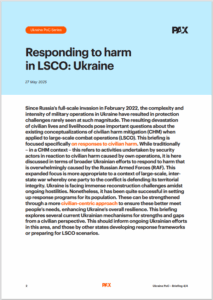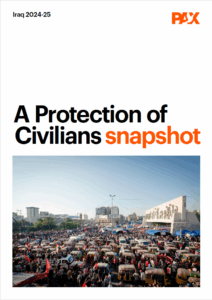The need for more data-driven protection
The PAX Protection of Civilians team has recently published its latest report “Mapping Data-Driven Tools and Systems for Early Warning, Situational Awareness, and Early Action”, researched and authored by independent consultant Allard Duursma.
When I* led the Protection of Civilians (PoC) office at the UN mission in Afghanistan, UNAMA, in 2011, our focus was on civilian casualty monitoring, reporting, and harm mitigation. The work was largely reactive: there were so many daily incidents to log at times, that we became focused solely on recording casualties. Initially, our reports focused on how many civilians were killed by each tactic and each party to the conflict. While the numbers were important, the way they could be leveraged to improve civilian protection was not always clear. Most importantly, how could we use the collected data to get ahead of the harm and stop it before it happens?
Today, missions continue to struggle with balancing reporting on civilian harm with how to actually protect civilians. It is not good enough to report on how many civilians have died when Protection of Civilians is more than just counting the dead. Today’s missions are focused on civilian harm prevention and measuring the mission’s effectiveness, asking questions like ‘when protecting civilians, how do you know you are having a positive effect?’; ‘How do you get ahead of the curve?’
In our latest report, Mapping Data-Driven Tools and Systems for Early Warning, Situational Awareness, and Early Action, we look at how the UN, and to a lesser extent the African Union and NATO, are using data to provide their forces with early-warning capabilities to shift focus to intervene in areas before they reach a critical point where civilians are harmed. In today’s missions it is no longer good enough to respond to civilian harm; rather, they need to foresee where and when to flow forces before violence escalates, engage with civil society to better understand the needs of the population, and measure their effectiveness so they can better provide services where they are needed.
Of the groups we looked at, the United Nations has spent the most time thinking of how to apply PoC strategies to missions. As such, it has developed robust data-reporting capabilities for information gathering and analysis. Further, it has created a number of coordinating mechanisms to improve PoC reporting and responses. In our report, we review a number of these mechanisms and provide concrete recommendations on how to better apply protection strategies. With the implementation of the Comprehensive Performance Assessment System (CPAS) and its continuing roll-out, the UN has taken clear steps to improve its ability to gather, analyze, and respond to PoC data.
NATO has focused its efforts on Civilian Harm Mitigation (CHM) and as such pioneered methodological advances in this field. In the decade since it first implemented CHM practices in Afghanistan, NATO has since realized the breadth of PoC and in 2021 released a new PoC handbook that greatly expands how the Alliance views civilian protection. However, NATO still suffers from a lack of early-warning tools and our analysis provides a number of key recommendations to improve how NATO applies PoC in the field beyond post-strike reactions.
The African Union has released guidelines on the protection of civilians and created the Continental Early Warning System – mandated to assess and analyze POC-related issues by collecting data on potential, emerging, and actual conflicts across the vast expanse of the African continent. Unfortunately, its AMISOM mission does not have a PoC mandate and it thus focuses solely on AMISOM-caused harm and misses expanding protection strategies to reducing harm from other actors. Still, the CIVCAS tracking is impressive, particularly because it is not limited to deaths but also to other types of harm not often recognized in kinetic harm models.
In Afghanistan, UNAMA and NATO eventually recognized that while we did not agree on the numbers of civilians killed in 2011, our trend lines matched; by analyzing these trends UNAMA was able to make key recommendations implemented by NATO, which led to a reduction in civilian casualties. A decade later, PoC has grown to encompass much more than just responding to civilian deaths. Hopefully, this paper is a step in recognizing how disparate security actors apply PoC within their missions with recommendations that will help them better analyze their data for early warning. While reporting on civilian harm is a critical part of PoC, stopping harm from occurring while providing a population with a safe, secure environment is the ultimate aim of civilian protection.
* Marc Garlasco is former Head of Civilian Protection at the United Nations Assistance Mission in Afghanistan (UNAMA) and is a member of the PAX Protection of Civilians team.
About this news
Date of publication:
Apr 14, 2021
Author:
Marc Garlasco
Download the report 'Mapping Data-Driven Tools and Systems for Early Warning, Situational Awareness, and Early Action'
